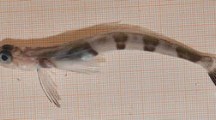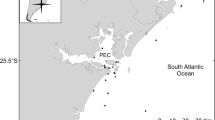Abstract
A total of 263 adult and preadult Chinese temperate bass Lateolabrax sp. caught at 20 locations in the coastal waters of western Japan from October 1999 to September 2008 were used for age, growth and maturity examinations. Examination of marginal increments of transverse sections of otoliths showed that rings (opaque zones) were formed once a year from spring to summer. According to the number of rings and the sampling month, ages were assigned to individuals. For males, we obtained the following von Bertalanffy growth equation: L(t) = 618{1 − e−0.420 (t + 0.273)}. Females attain sizes over 600 mm SL mainly after 5 years of age and attain sizes of 850–1,000 mm SL at 8–10 years and over 1,100 mm SL about 15 years. Based on histological examinations of gonads and seasonal changes in gonadosomatic indices, potential spawning period was confirmed during mid-October to late January. In males, the minimum size and age at first maturity were estimated as 380 mm SL and 2 years old, respectively, though most males reach sexual maturity at 3–4 years old. Furthermore, female specimens at the mature or developing stages were over 470 mm SL and 4 years old.








Similar content being viewed by others
References
Bi X, Yang D, Zhao Z, Wang S (1983) Preliminary investigation on fisheries biology of Chinese temperate bass in Bohai Sea and Yellow Sea. Chinese J Zool (3):39–42
Chen D, Gao T, Zeng X, Ren Y, Ruan S (2001) Study on the fishery biology of Laizhou population of Lateolabrax sp. Acta Oceanologica Sinica 23:81–86
Feng Z, Zhan F, Huang C (1985) Growth of Chinese temperate bass in Bohai Sea and north Yellow Sea. Fish Sci China 4:10–15
Hatooka K (2002) Moronidae. In: Nakabo T (ed) Fishes of Japan with pictorial keys to the species, English edn. Tokai University Press, Tokyo, p 683
Hayashi I (1971) On the process of the testicular maturation of the Japanese sea bass, Lateolabrax japonicus. Jpn J Ichthyol 18:39–50
Hayashi I (1972) On the ovarian maturation of the Japanese sea bass, Lateolabrax japonicus. Jpn J Ichthyol 19:243–254
Hirota Y, Ikeda M, Setokuma T, Mochizuki K (1999) New record of Chinese sea bass. Lateolabrax sp., from the coastal area of Kanto, central Japan. J Nat Hist Mus Inst, Chiba 5:103–108
Kimura H, Hayashi Y, Murata M (1995) Survey on the natural fish resources of Japanese temperate bass, flatfishes and tiger puffer. Bull Yamaguchi Pref Naikai Fish Exp Stn 24:123
Kosaka M (1969) Ecology of the common sea bass, Lateolabrax japonicus in Sendai Bay. J Coll Mar Sci & Tech, Tokai Univ 3:67–85
Li X (1997) A preliminary study on feeding habits of Lateolabrax japonicus in the Bohai Sea. J Fish Sci China 4:86–89
Matsukiyo K (1973) Report of survey on ecology of fishery resources at marine ranching ground. Data of Nagasaki Pref Fish Exp Stn 354:53–59
Matsuoka S (2000) Study about the status of diseases occurrence and Pasteurella piscicida infections in cultured marine fish at Ehime Prefecture. Bull Ehime Pref Fish Exp Stn 8:1–21
Ochiai A, Tanaka M (1998) Ichthyology (new version), Part 2. Koseishakoseikaku, Tokyo, pp 675–691
Omi H, Nabeshima Y, Kusakabe T (1998) Survey on particular commercially important coastal fish resources (Japanese temperate bass). Annu Rep Osaka Pref Fish Exp Stn:86–98
Omi H, Nabeshima Y, Kusakabe T (1999) Survey on particular commercially important coastal fish resources (Japanese temperate bass). Annu Rep Osaka Pref Fish Exp Stn:100–108
Omi H, Nabeshima Y, Kusakabe T (2000) Investigation for establishment of management plan on gill net fishery for Japanese temperate bass. Annu Rep Osaka Pref Fish Exp Stn:124–129
Sun G, Zhu Y, Zhou Z, Chen J (1994a) The reproductive biology of Lateolabrax japonicus in the Yangtze River estuary and Zhejiang offshore waters. J Fish China 18:18–23
Sun G, Zhu Y, Chen J, Zhou Z (1994b) Growth and feeding habits of Japanese sea-bass Lateolabrax japonicus in the estuary of Yangtze River. J Fish China 18:183–189
Ui S (1998) Rapid expansion of distribution of Chinese temperate bass. Marine Pavilion (Magazine of Kushimoto Marine Park) 27:2
Wakabayashi I, Nakamura M (2003) Report of Chinese temperate bass. Lateolabrax sp., from the coastal area of Shima Peninsula. News of Wildlife at Mie Pref 16:2–3
Wan R, Chen R (1988) Reproductive behavior and early development of Lateolabrax japonicus (Cuvier & Valenciennes) in the Bohai Sea. Mar Fish Res 9:203–211
Wu G, Yang D, Pang H (1983) The spawning of perch Lateolabrax japonicus (Cuvier & Valenciennes) in Bohai Bay. Mar Sci (6):40–45
Wu G, Yang D, Pang H (1984) The characteristic of the early development stages of the perch Lateolabrax japonicus (Cuvier et Valenciennes). Mar Sci (3):43–46
Xiao X, Liu S (1987) Study about age and growth of Chinese temperate bass in Pearl River estuary. Pearl River Fisheries 9:17–26
Yokogawa K (2002) East Asian fishes of genus Lateolabrax. In: Tanaka M, Kinoshita I (eds) Temperate bass and biodiversity—new perspective for fisheries biology. Koseishakoseikaku, Tokyo, pp 114–126
Yokogawa K, Seki S (1995) Morphological and genetic differences between Japanese and Chinese sea bass of genus Lateolabrax. Jpn J Ichthyol 41:437–445
Yokogawa K, Suetomo K, Murakami K, Shibuya R, Seki S, Tujino K, Miyagawa M (1996) Morphological and genetic features of sea bass, so-called “hoshisuzuki”, from waters around Shikoku, Japan. Jpn J Ichthyol 43:31–37
Acknowledgments
We would like to thank H. Shoji, other commercial fishermen, anglers and staff of various prefectural fisheries experimental stations for their great help in collecting samples and in providing useful information. We are grateful to K. Okutani for provision of farmed specimens and K. Kinugawa for useful information about the actual conditions of Lateolabrax sp. farming. We also express our gratitude to T. Ohkawa, M. Hibino, T. Isoda, Y. Yube and other graduate students and staff at the Graduate School of Agriculture, Kyoto University, for their great assistance in collecting specimens and helpful advice.
Author information
Authors and Affiliations
Corresponding author
About this article
Cite this article
Iseki, T., Mizuno, K., Ohta, T. et al. Current status and ecological characteristics of the Chinese temperate bass Lateolabrax sp., an alien species in the western coastal waters of Japan. Ichthyol Res 57, 245–253 (2010). https://doi.org/10.1007/s10228-010-0161-7
Received:
Revised:
Accepted:
Published:
Issue Date:
DOI: https://doi.org/10.1007/s10228-010-0161-7




